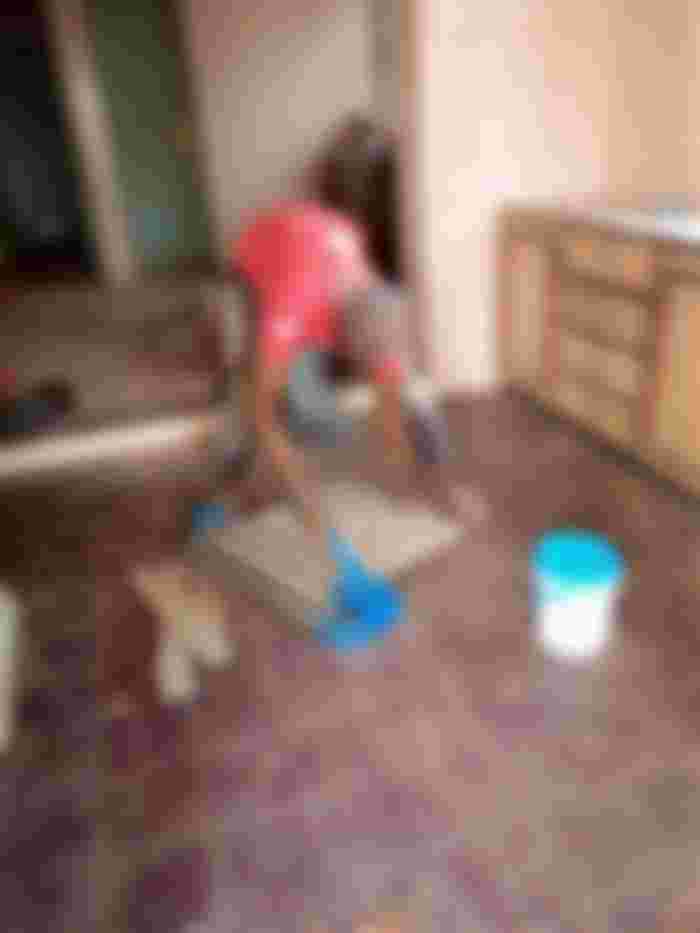First:-My TOOLS
tile spacers
sponge
bucket
Normal trowel
tile cutter
broom
chalk line
Tiles pinchers
Mullet and plum e.t.c

MATERIALS
thin-set mortar
grout
tiles
White cement
Cement
Sharp and blaster sand e.t.c
Laying Floor Tiles
The first step in laying floor tiles is to have the right equipment. You will need a trowel with the right sized grooves for spreading the thin-set.
You will need the right diamond saw to cut the tile without breaking it. Then laying the tile you’ll need the right base.
Prep your tile by buying enough and laying out the pattern before you start. Once you place the tile you’ll need to grout.
Work your grout so that it gets the right consistency and doesn’t have air bubbles. Then follow the steps to clean up the grout so your finished tiling looks beautiful. You need to clean and prep your surface before you tile. Remove any grease, dirt, or fingerprints.
If you don’t do this step, the adhesive won’t stick to the wall. This is an issue most common when tiling bathroom or kitchen walls.
When cutting tile, take some precautions to make sure you do not break them. Too many broken tiles will become wasteful and expensive.

Using a diamond wet saw is the best method for cutting tile. A diamond saw blade is abrasive and not toothed.
Before cutting, mark the tile with a pencil. You can use a regular lead or grease pencil for this.
Place the tile against the fence and line up the line with the blade. You will need to wait for the water to flow after turning the saw on.
Use a slow even pressure while making your cut. As you get to the end of your cut push the two halves together. Holding the tiles stops them from breaking.

If you hear the blade slow down as your cutting then you are pushing too fast. The harder the material you’re cutting is, the slower you need to go. And again Cracked tiles are usually the result of other underlying issues, mostly likely incorrect installation. However, it could also be due to extreme temperature changes, cracks in the substrate (or surface the tile is laid on), supporting too much weight or something as simple as a heavy item being dropped on them. If you ask how do you stop your tile from cracking? You should make sure that an anti-fracture membrane has been laid between your tile and the subfloor. Anti-fracture membranes are designed to absorb any cracking energy and disperse it across a larger area of the floors. This keeps all that pressure off of a single tile and prevents cracking. And again let me tell you foundation problems can also cases it, If you ask how?...In Many Cases, Cracked Tile Floors Are Signs Of Foundation Issues. ... Sometimes hairline cracks in tile floors are one of the first tell-tale indications that soil or moisture is affecting a foundation. Poor drainage that is allowing water to enter your slab foundation can lead to significant deterioration.

Laying Wall Tiles
Wall tile is trendy … that’s for sure. It’s both practical and luxurious for kitchens and bathrooms. In fact, good-looking tile can add a fashion-forward note to just about any wall in your home. While hiring an experienced tiles contractor is a safe bet, if you have plenty of time and patience, you might want to learn how to lay wall tiles yourself. My fellow tilers always say that Starting wall tiles sometimes is hard because you must form it very well so that when you start to put another one on top it will not fall, wall tiles takes time more than floor tiles that is what I notice. But if you ask me, Is it hard to lay tile on wall? It's not particularly hard to do, but it's easy to do poorly. Because you are attaching a relatively heavy material to vertical surfaces, it is somewhat trickier than installing floor tile, but with careful planning and patience, any DIYer can readily install ceramic wall tile with good results.

Now if you ask, where do you start when laying tile on a wall?
It's always advisable to start tiling your grid in the centre of the wall, as it's easier to make sure your pattern is symmetrical. It also means any half-tiles you may need can go at the end of each row and will be of matching size. Again here's how you do it: Install the first four tiles in a pyramid: three on the bottom and one on top. Every subsequent row is a process of draping over the pyramid, back and forth. Begin your first drape on either the right or left side, and bring it up, over, and down the other side.


Where To Use Wall Tile
Backsplashes
Walls of shower area or entire bathroom
Kitchen walls
Anywhere you want a bright note of color and/or texture
CAUTION: Be careful about using wall tile as a flooring material. Ceramic wall tiles often just aren’t tough enough to stand up to foot traffic.
Not Buying Enough Tile Is Not Good In Tiling
The main reason for not buying enough tile is because you failed to plan ahead. Take the time to make the proper measurements and then check them.
Start by measuring the length and width of the area you plan to tile. Multiply your measurements by 2.
This gives you the square footage. Divide the square footage that comes in the box of tile by your room’s total square footage.
This number is how many boxes it will take to cover the floor. Next, you need to calculate the overage.
Multiply your room’s square footage by 10% and then add this to the room’s number. Then divide by a single box square footage.
This new number is how many boxes you need to buy. The extra boxes will cover cuts, breakage, and waste.
Doing tiles work is it hard?
Laying tile is easy but laying tile and doing it well is difficult. From that angle, it may make more sense to hire a professional tiler than to do it yourself. If you're trying to save money, one way to approach it is to hire the pro for the most visible areas.
SIGNS OF A POOR TILE JOB
1. Obvious mistakes such as crooked lines, corners not aligned, or uneven grout line spacing.
2. Excessive lippage, overhangs, jutting, or popping up of corners.
3. Tiles are loose or corners have lifted upward.
4. Water is not draining or continues to leak.
5. The tile is cupping or bowing inward or outward.
4 Ways To Make Tile Floors Shine Without Wax
Tile flooring
is among the classy flooring options with an ever-rising market demand. The flooring comes in a wide range of colors that blends fantastically with nearly all the stylish interior décor. Due to their resistance to abrasion and scouring, floor tiles are increase versatility in designs and interior décor. With tile flooring, your styles and patterns are endless as you can use them in the living room, kitchen, bathroom, and any other part of the house.
However, all tile floors can become grimy and dull when neglected. Tile floors lose their shine due to masking by stains, dirt and dust spread over it by the footwear. Even though many people use wax to shine tile floors, there are other ways to shine tile floors without wax. Below are some of the do-it-yourself means of making floor tiles shine without wax.
1. Soapy Water
A mixture of soap and warm water can be of great help in this process. To make your soapy solution, you should add detergent into a mop bucket containing warm water and mix thoroughly to form a soapy solution. Once the solution is ready, you need a mop to apply the soapy solution in the following procedure.
Dip the mop in the soapy solution and wring appropriately before using it on the floor.
Mop the floor using the cleaning solution and a mop.
Replace the solution when it turns dirty to avoid leaving dirt streaks on the floor.
Use a soft brush or a sponge to scrub the stain spots gently.
Rinse the floor using clean water.
2. Baking Soda
Baking soda may be useful in cleaning stains on the tile floor. The baking soda is one of the best cleaners that work well on stains and dirt. All you will have to do is to make your soda cleaning solution using the following procedure:
Warm two gallons of water and pour it in a mop bucket
In the warm water, add ¼ cup baking soda, one tablespoon liquid dish washing shop and ¼ cup white vinegar
You can also consider adding a few drops of lavender essential oil to keep your house with a fresh scent.
Mix the baking soda thoroughly with warm water to form a paste.
Allow the baking soda to settle on the tiles for about 10 minutes before rinsing the floor tiles with clean water.
Repeat the previous process in case of persistent stains on the tile floor.
Dry the surface to remove excess moisture.
3. Ammonia-Water Solution
Ammonia is one of the best floor cleaners with remarkable result in removing floor stains and restoring the shine on floor tiles. You can add a few drops of ammonia into warm water in a mop bucket and mix well. After that, dip the mop into the cleaning solution and wring thoroughly to avoid excessive application of the cleaning solution. Thoroughly mop the floor, removing stains, dirt and disinfecting the floor at the same time.
In case of persistent stains, use a sponge soaked with the cleaning solution and scrub the stains gently. After cleaning with ammonia solution, you should rinse the floor adequately with freshwater and dry-mop the floor.
4. Use Of Vinegar Solution
Vinegar provides a natural tile cleaning solution that is effective for both cleaning the soil and disinfecting the floor. When the vinegar dries up, it leaves a natural scent on the floor that makes the room smell fresh. Ensure the floor is swept clean before using the vinegar solution. The following steps will guide you on how to make a vinegar solution for cleaning floor tiles.
Ensure the windows are fully open for proper air circulation.
Mix a half-cup full white vinegar into two-gallons of water in a mop bucket.
Dip your mop into the cleaning solution and wring it up to avoid applying the excess solution onto the floor.
Thoroughly clean the floor using the solution while moving your mop in forth-backward motions to ensure that you remove all the dirt.
Dry-mop the floor using a clean towel to ensure you clean all the moisture and leave the floor to dry.
In case of stubborn stains, sprinkle some baking soda and scrub gently until the stain comes out. Remember does not mix the vinegar solution with any form of bleach to avoid health hazards.
Having the basic knowledge on how to make tile floors shine, you can make your effective cleaning solution at a lower price. You can make your choice from the above options or use a combination of some of the methods to maintain a shine on your floor tile surface. The techniques are simple to use, and the materials are available too at an affordable price. If you are not sure of how to work it out, you can use commercial cleaners.
You have to know this, If you've never taken on a tiling project before, you might be surprised by the many different types of tiles available. Ceramic and porcelain tiles are the most popular, but there are also glass tiles, cement tiles, metal tiles, and stone tiles—to name just a few. To make it even more confusing, not every type of tile works for every job. And, of course, there's your budget to consider. It's hard not to feel a little overwhelmed.
My works... I always deliver neat and beautiful work and also I deliver it in time, pass many years now people have not complain or say bad things when ever I finish working for them🙅🏻♂️.



Conclusion
Just multiply your total area in square meter to the factors above and you should get a conservative materials estimate for your tiling works. The factor for the labor cost is around 30% – 45% of the total materials cost.
I thank you all for your precious time reading my article 🙋🏻♂️(Bitcoin cash carry go👍
Thanks
@Christian_BCH 💖🙋🏻♂️









